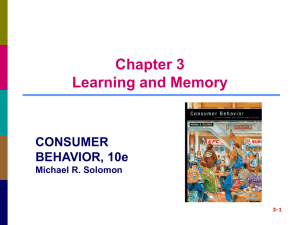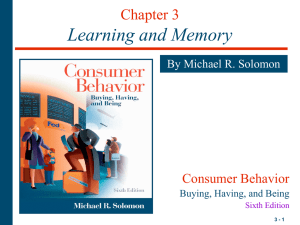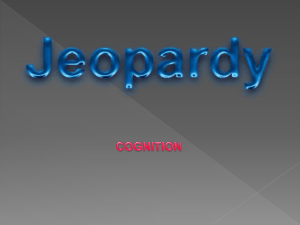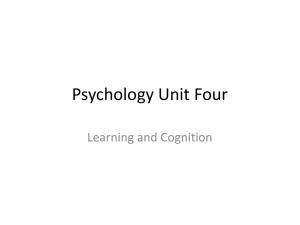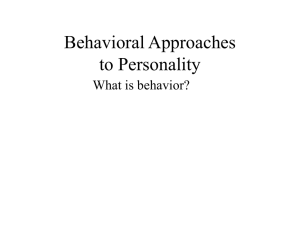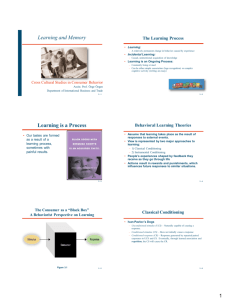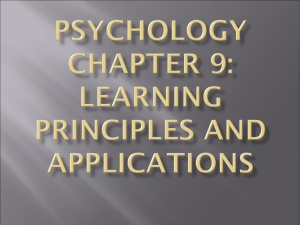Review3
advertisement
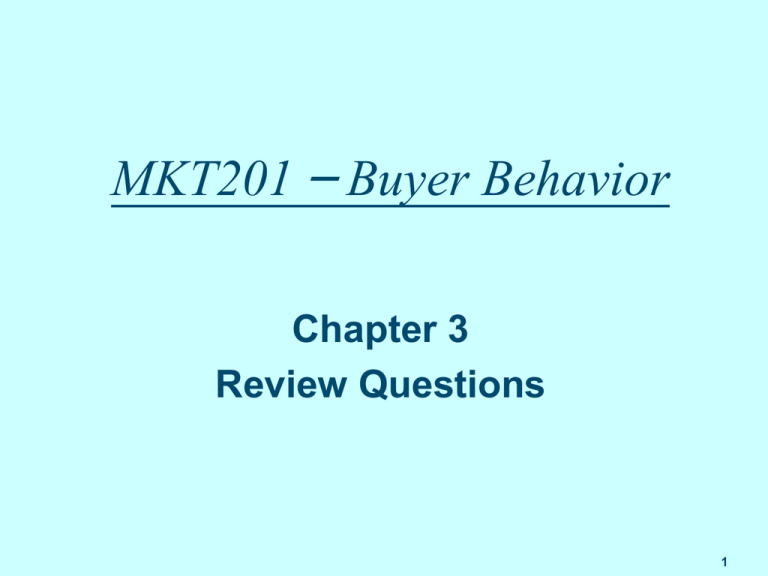
MKT201 – Buyer Behavior Chapter 3 Review Questions 1 Learning & Memory: studies how consumers learn about products & services 1. The Learning Process – what is learning; - ongoing process; - incidental learning 2. Conditioning results in learning – Behavioral Learning Theories (1) Assumption – learning takes place as the result of responses to external events (2) Two views Classical conditioning: CS+UCS->Response (CS: credit card, brand name; UCS: music, imagery, humor) - Repetition: enhance the association between CS and UCS Avoid advertising wearout - Stimulus generalization: UCS + other CS similar to original CS ->Same response Halo effect; Family branding; Line-extension; Me-too products; Look-alike pack; Masked marketing - Stimulus discrimination: other CS similar to original CS not followed by original UCS -> reaction will be weakened and soon disappear positioning; anti-knockoffs Instrumental conditioning: (consumers learn to perform behavior that product + & avoid those that yield -) To strengthen behavior: positive reinforcement (frequent marketing); negative reinforcement; punishment; extinction (if reinforcement not longer needed) 2 3. Observation of others’ behavior results in learning – Cognitive Learning Theories (1) Assumption – people as problem solver who actively use information to master environment; Stress the importance of internal mental process (2) Observational learning – we watch others and note reinforcements they receive for behaviors Modeling: imitating the behavior of others (celebrity endorsement) Components of observational learning: Attention; Retention; Production processes and Motivation 4. The Role of Memory in Learning (1) The Memory Process – Encoding, Storage, Retrieval (2) Memory Systems – SM, STM, LTM (3) Activation Models of Memory ( vs. multiple store models of memory) Associative networks Spreading activation Levels of knowledge (4) Retrieving information for purchase decision (5) Factors Influencing Forgetting (6) Products as memory makers (7) Measuring memory for marketing stimuli 3 1. Which form of learning listed below assumes that learning takes place as the result of responses to external events? a. b. c. d. Behavioral learning Cognitive learning Incidental learning Gestalt learning 4 2. Stimulus generalization refers to ________. a. the tendency for stimuli to be similar in nature b. the situation when a stimulus similar to a conditioned stimulus is not followed by an unconditioned stimulus c. the tendency of stimuli similar to a conditioned stimulus to evoke similar, conditioned responses d. the tendency for the consumer to rationalize purchases for general reasons 5 3. With respect to the application of instrumental conditioning principles, a popular technique known as ________ reinforces regular purchases by giving consumer prizes with values that increase along with the amount purchased. a. b. c. d. rebate marketing discount marketing reward marketing frequency marketing 6 4. What type of learning emphasizes that customers are active in making decisions using the information that surrounds them? a. instrumental conditions b. classical conditioning c. cognitive learning d. operant conditioning 7 5. Recently, Miller Brewing Co. wanted to try a new approach to reach consumers who had previously been uninterested in Miller products. It created a dummy company called Plank Road Brewery when it launched its Icehouse and Red Dog beers. Consumers who purchased these products never knew that they were really part of Miller's product line. This strategy is called ________. • • • • dual branding covert branding deceptive branding masked branding 8 6. Claudia Norman was a marketing consultant. She recommended that brand equity for a new environmentally friendly product could be established by calling the product "Xy2Y" and always matching the name with a beautiful picture of a pristine landscape. Claudia was utilizing the advantage of what type of learning in her recommendation? a. b. c. d. operant conditioning cognitive learning classical conditioning instrumental conditioning 9 7. In relationship to classical conditioning, when marketing an old, established product ________ should be encouraged, while ________ should be encouraged when marketing a new product. a. b. c. d. repetition; product association look-alike packaging; licensing stimulus discrimination; stimulus generalization extinction; shaping 10 8. A department store decides to use "secret shoppers" to test for service quality among its personnel. Store personnel are rewarded for "excellent service attitudes." Which of the following reinforcement schedules would most likely apply in the this situation? a. Fixed-ratio reinforcement b. Fixed-interval reinforcement c. Variable-ratio reinforcement d. Variable-interval reinforcement 11 9. As May-Lee considers her purchase of perfume, she shifts back and forth between thinking about claims made by the different brands, remembering ads she has seen, and considers her emotional responses to the various brands. Which of the following processes most accurately describes what May-Lee is going through? a. b. c. d. spreading activation advertising decay polar parallels scalar processing 12 10. In a typical ________ test, subjects are shown ads one at a time and asked if they have seen them before. a. recall b. recognition c. remembrance d. recovery 13 Essay Questions: 1. Discuss what stimulus generalization and stimulus discrimination are and present an example of each that is relevant to the field of marketing. – Stimulus generalization refers to the tendency of stimuli similar to a conditioned stimulus to evoke similar, conditioned responses. The idea is that people react to other stimuli (similar stimuli) in much the same way they respond to the original stimuli. For example, a drug store's bottle of private brand mouthwash might be deliberately packaged so as to resemble a name brand (such as Listerine). The consumer would assume this "me-too" product has the same characteristics as the name brand and buy it because of its lower price. Stimulus discrimination occurs when a stimulus similar to a conditioned stimulus is not followed by an unconditioned stimulus. In this case, reactions are weakened and will soon disappear. National manufacturers remind consumers that if they buy cheaper brands they will not get the same results as they do when they buy the national brand. – 14 Essay Questions: 2. – – – – An important factor in instrumental (operant) conditioning is the set of rules by which appropriate reinforcements are given for a behavior. The chapter discusses four possible schedules of reinforcement. Briefly describe each and give a short example. Be sure to use the proper terminology for each schedule. Fixed-interval reinforcement—After a specified time period has passed, the first response that is made brings reward. Under such conditions, people tend to respond slowly right after being reinforced, but their responses speed up as the time for the next reinforcement looms. Example: crowding a store on the last day of a sale but not returning for another year. Variable-interval reinforcement—After a variable unspecified time period has passed, the first response that is made brings reward. Because the person does not know exactly when to expect the reinforcement, responses must be performed at a consistent rate. Example: using mystery or secret shoppers to watch store employees and their attempt to provide quality service. Fixed-ratio reinforcement—Reinforcement occurs only after a fixed number of responses. This schedule motivates people to continue performing the same behavior over and over again. Example: repeat shopping to earn prizes by earning credits or trading stamps. Variable-ratio reinforcement—The person is reinforced after a certain number of responses, but he or she does not know how many responses are required. People in such situations tend to respond at very high and steady rates, and this type of behavior is very difficult to extinguish. Example: gambling or playing slot machines. 15
